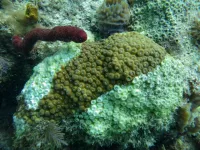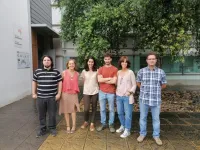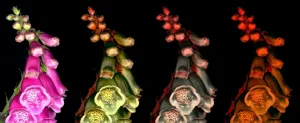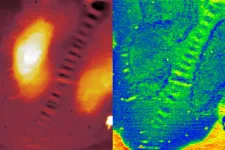Study finds genes role in immune response of Florida corals to rapidly spreading disease
Researchers document gene expression response to stony coral tissue loss disease
2021-07-06
(Press-News.org) MIAMI--A new study led by scientists at the University of Miami (UM) Rosenstiel School of Marine and Atmospheric Science is the first to document what coral genes are doing in response to a disease that is rapidly killing corals throughout Florida and the Caribbean. The findings can help to better understand coral immune system as new diseases emerge as the ocean warm.
The collaborative effort between researchers at the UM Rosenstiel School, Mote Marine Laboratory and the Smithsonian Marine Station is the first to document a gene expression response of corals to stony coral tissue loss disease and that the disease causes a shared immune response in at least two coral species -- mountainous star coral (O. faveolata) and great star coral (M. cavernosa).
"This work is vital in our efforts to save Florida's coral reefs," said the study's lead author Nikki Traylor-Knowles, an assistant professor of marine biology and ecology at the UM Rosenstiel School. "It is imperative that we better understand their immune system and how it may be helping or hindering their health in the face of climate change and disease."
Since first appearing in 2014, stony coral tissue loss disease has spread throughout most of Florida's coral reef as well as others in the Caribbean and has affected over 20 coral species to date.
In this study, the researchers exposed healthy corals to stony coral tissue loss disease in order to-- study their reaction on a cellular level. They found a network of genes important for cell responses including cell death, immunity and tissue rearrangement, indicating that the disease is causing swift cell death and rearrangement of the tissue.
An interesting set of genes uncovered by the researchers -- peroxidases -- are known to be important for stress response in invertebrates and were found to play an important role in the late stage reaction of the disease in corals.
INFORMATION:
The study, titled "Gene Expression Response to Stony Coral Tissue Loss Disease Transmission in M. cavernosa and O. faveolata from Florida," was published in the journal Frontiers in Marine Science. The coauthors include: Nikki Traylor-Knowles, Michael T. Connelly, Benjamin D. Young, Melissa K. Drown, Ashley Goncalves, Grace A. Snyder, Allyson DeMerlis, Cecily Martin, Nicholas Kron and Kevin Rodriguez from the UM Rosenstiel School; Katherine Eaton and Erinn M. Muller from Mote Marine Laboratory; and Valerie J. Paul and Blake Ushijima from the Smithsonian Marine Station.
The study was funded by the Florida Department of Environmental Protection (grant # PR11155032).
[Attachments] See images for this press release:

ELSE PRESS RELEASES FROM THIS DATE:
2021-07-06
Metal-organic frameworks (MOF) are crystalline porous organic-inorganic hybrid materials that, by filling its pores with guest molecules, can create functionalities through interactions between the organic-inorganic based frameworks of MOF (host) and its guest molecules. This host-guest chemistry has the potential to bring "designable" electrical properties, allowing for a material to be organized in ways never before possible - paving the way for the next-generation of thin-film smart devices.
"However, most MOFs exhibit poor electrical conductivity", states Professor Masahide Takahashi, ...
2021-07-06
Philadelphia and Santiago -A new study published in The Lancet Global Health showed that establishing safe nurse staffing standards in hospitals in Chile could save lives, prevent readmissions, shorten hospital stays, and reduce costs.
The study, by the Center for Health Outcomes and Policy Research (CHOPR) at the University of Pennsylvania School of Nursing, and the Universidad de los Andes - Chile School of Nursing, found very large variations in patient to nurse staffing across 40 hospitals located throughout Chile. Nurse staffing was significantly ...
2021-07-06
SAN ANTONIO -- July 6, 2021 -- Scientists have used data from the Southwest Research Institute-led Magnetospheric Multiscale (MMS) mission to explain the presence of energetic heavy elements in galactic cosmic rays (GCRs). GCRs are composed of fast-moving energetic particles, mostly hydrogen ions called protons, the lightest and most abundant elements in the universe. Scientists have long debated how trace amounts of heavy ions in GCRs are accelerated.
The supernova explosion of a dying star creates massive shockwaves that propagate through the surrounding space, accelerating ions in their path to very high energies, creating ...
2021-07-06
A research group at the University of Cordoba has conducted study focused on evaluating the potential of the Sentinel-2 sensor system's configuration to predict the amount of forage on permanent Mediterranean grasslands.
Pasture quality assessment in permanent grasslands is essential for their conservation and management, as it can facilitate real-time decision-making regarding livestock management. In this regard, the Sentinel-2 satellite constellation, launched in 2015, has proven to be a promising tool for permanent grassland monitoring. This is a sensor system developed by the European Space Agency (ESA) and that provides free and available data worldwide, with a review time of five days, and 13 spectral bands. The spectral configuration of Sentinel-2, ...
2021-07-06
Scientists from the European Molecular Biology Laboratory (EMBL) and the German Cancer Research Center (DKFZ) have presented a new method for generating metabolic profiles of individual cells. The method, which combines fluorescence microscopy and a specific form of mass spectroscopy, can analyze over a hundred metabolites and lipids from more than a thousand individual cells per hour. Researchers expect the method to better answer a variety of biomedical questions in the future.
Today, many biomedical disciplines focus their attention on the metabolites of individual cells. While in the past these were considered simply as degradation products or else building blocks for the synthesis of complex cellular molecules, ...
2021-07-06
Changes in the colour and intensity of light pollution over the past few decades result in complex and unpredictable effects on animal vision, new research shows.
Insect attraction to light is a well-known phenomenon, but artificial lighting can also have more subtle consequences for species that rely on night-time vision for their behaviour.
To explore these effects, University of Exeter researchers examined the impact of more than 20 kinds of lighting on the vision of moths, and birds that eat them.
The study found that elephant hawkmoth vision was enhanced by some types of lighting and disrupted by others, while the vision of birds ...
2021-07-06
While atomic force microscopy and scanning electron microscopy have already provided information on the morphology of bitumen surfaces in the past, for a long time it was not known whether surface and chemical composition correlate with each other. However, the chemical composition of the surface is of particular interest because oxidation processes take place there, triggered by oxygen-containing molecules in the air such as ozone, nitrogen oxides or hydroxyl radicals. The oxidation process accelerates the aging of the material - the bitumen becomes porous and damage develops.
The materials ...
2021-07-06
Metals with similar chemical properties are usually extracted together, which limits the opportunities to separate high-purity metals. To increase those opportunities, it's important to understand how different metal species act during the solvent extraction process.
Researchers from the Institute of Process Engineering (IPE), of the Chinese Academy of Sciences, have developed a new strategy to characterise polymeric transition metal species in acidic solution, which may help to separate those high-purity metals.
Their study, which was published in the KeAi journal Green Chemical Engineering (GreenChE) employed a high-resolution electrospray ionization ...
2021-07-06
A multidisciplinary research team, led by the CSIC biologist at CRAG, Ana I. Caño Delgado, and the physicist from the University of Barcelona, Marta Ibañes, has discovered that two plant stem cell proteins, known for their role in the correct development of the root, physically interact and regulate each other to avoid cellular division. The study, result of fifteen years of continued research carried out by the two researchers, reveals that these two proteins, known as BRAVO and WOX5, act in a specific manner in a small group of stem cells, and that their interaction is key to the plant's survival under genomic and environmental stress factors like extreme cold, heat, or floods. The results, obtained with the model plant Arabidopsis thaliana, have recently been published in the ...
2021-07-06
A team of researchers at the Department of Chemistry and Pharmacy at Friedrich-Alexander University Erlangen-Nürnberg (FAU) has successfully solved the problem of finding a straightforward, cost-effective process for producing hexaarylbenzene molecules with six different aromatic rings. These molecules are important functional materials. The results were published in the reputable journal Angewandte Chemie.
Until now, it has been possible to use certain chemical procedures to produce simple, symmetrical hexaarylbenzene (HAB) molecules, in which the hydrogen atoms of the benzene are replaced by the same atomic groups. However, only very little HAB was produced in this way.
The team of researchers led by Prof. Dr. Svetlana Tsogeva and Prof. Dr. Norbert Jux, both professors of organic ...
LAST 30 PRESS RELEASES:
[Press-News.org] Study finds genes role in immune response of Florida corals to rapidly spreading disease
Researchers document gene expression response to stony coral tissue loss disease








